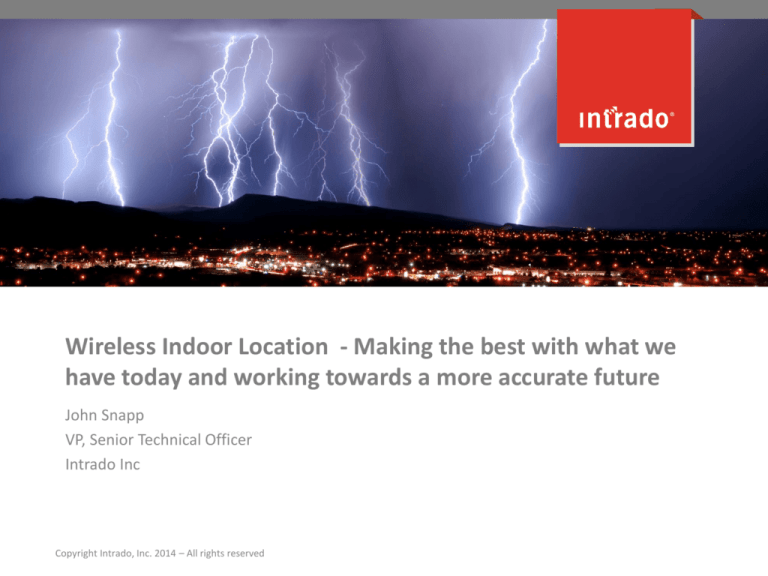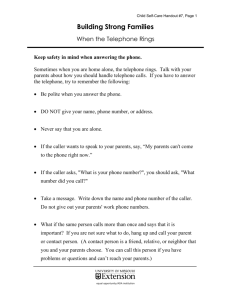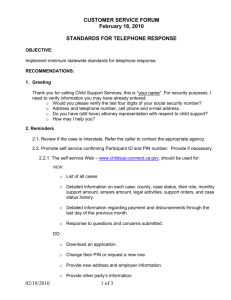
Wireless Indoor Location - Making the best with what we
have today and working towards a more accurate future
John Snapp
VP, Senior Technical Officer
Intrado Inc
Copyright Intrado, Inc. 2014 – All rights reserved
The evolving mobile landscape
•
•
•
•
Home phones are rapidly being replaced with mobile phones
The total percentage of 9-1-1 calls from mobile devices continues to increase
Small cells and femto cells are being deployed in enormous numbers
Phase 1 locations are no longer always less accurate than Phase 2 locations
– Enterprise Femto cells
– Personal Femto cells
– Indoor only cell sites
•
Cell site addresses for large macro cell sites provide marginal value and add
confusion
– Originally sent because CAD systems could not use a X/Y
– Creates confusion between dispatchable and non dispatchable addresses
•
•
Competition in Smart Phone technologies are driving innovation in location
technologies
Cellular and VoIP technologies are merging together in the mobile market
Copyright Intrado, Inc. 2014 – All rights reserved
2
Today – Making the most of what we have
Uncertainty is the single most important piece of information to understand the
area a mobile 9-1-1 caller is most likely contained within surrounding the X/Y.
•
•
Confidence : Typically fixed at 90% and is not helpful to the Telecommunicator.
Is a value into the computation of the uncertainty areas by the carriers
location equipment.
Uncertainty : Is the area the mobile caller is most likely within. It does not
define the accuracy of the location.
Copyright Intrado, Inc. 2014 – All rights reserved
3
Understanding Uncertainty and Confidence
Phase 1
Location
Phase 2
Location
9-1-1 Caller
Location
Actual Caller
Location
Actual Caller
Location
9-1-1 Caller
Location
Uncertainty
Radius
Uncertainty
Radius
Confidence = 90%
There is a 90% chance that the callers actual
location falls within the uncertainty area
Copyright Intrado, Inc. 2014 – All rights reserved
4
Preparing for the future : Determining a dispatchable location
Public safety does not dispatch to a X/Y:
39° 41’ 11.93” N Latitude
104° 58’ 54.72” W Longitude
5M Point Radius Uncertainty
They dispatch to an address
Reverse Geocoding
Nearest Intersection
Reverse Geocoding
Address Range
Reverse Geocoding
Point Match
S Pennsylvania St & E Iowa Ave
Denver, CO
1600-1650 S S Pennsylvania St
Denver, CO
1615 S Pennsylvania St
Denver, CO 80210
Copyright Intrado, Inc. 2014 – All rights reserved
5
How is an address determined for a mobile call
1.
2.
3.
4.
5.
6.
7.
9-1-1 call is placed by mobile subscriber
Mobile network starts location process
Proper PSAP is determined by Cell ID and call is routed to the proper PSAP
PSAP receives mobile 9-1-1 call and queries ALI for X/Y location
PSAP CPE receives X/Y location and passes it to CAD/MAPS
CAD/MAPS typically plots X/Y on screen and sometimes uncertainty area
CAD/MAPS typically provides Telecommunicator an address through the
process of reverse geocoding
1. As a nearby intersection
2. As an address range
3. As a point address
Copyright Intrado, Inc. 2014 – All rights reserved
6
Location Errors introduced because of Reverse Geocoding
•
•
•
•
•
•
•
Reverse Geocoding is only as accurate as the base maps it utilizes
Today base map data is generally not of sufficient resolution to provide reliable
dispatchable addresses through reverse geocoding.
Most PSAPs use local City/County base map data based upon street centerline
data
A few PSAPs are using better base map data but deployment is very slow and
very expensive.
Reverse Geocoding is a “Best Guess” of the nearest address
What's the value of a more accurate X/Y location if the reverse geocoding
processes adds 100’s or 1000’s of additional error
Reverse Geocoded locations are less accurate than the X/Y they are derived
from and create a perception that mobile location was less accurate than it
actually was.
Copyright Intrado, Inc. 2014 – All rights reserved
7
How Reverse Geocoding Works
• Yellow dots are assigned addresses
• Black dots are unassigned addresses
Copyright Intrado, Inc. 2014 – All rights reserved
8
R.G. Address
1649 S Pennsylvania St
Actual Address 1645 S Pennsylvania St
Copyright Intrado, Inc. 2014 – All rights reserved
9
R.G. Address
1653 S Pennsylvania St
Actual Address 1645 S Pennsylvania St
Copyright Intrado, Inc. 2014 – All rights reserved
10
Reverse Geocoding Results – Case Study
Intrado conducted a study to determine the errors introduced through reverse
geocoding from a large sample of simulated 9-1-1 calls made from the center of
the primary structures at surveyed addresses. For these simulations, the
uncertainty of the X/Y was 0 meters.
Results:
• Centerline Data – Typical county base map
– Rural – 98% Of the time, wrong address was returned
– Suburban – 98% Of the time, wrong address was returned
– Urban – 79% Of the time, wrong address was returned
•
Commercial Data – Best combined sources
– Rural – 62% Of the time, wrong address was returned
– Suburban – 63% Of the time, wrong address was returned
– Urban – 15% Of the time, wrong address was returned
Copyright Intrado, Inc. 2014 – All rights reserved
11
Determining a Dispatchable Location
•
For Public Safety to effectively dispatch help to an emergency caller a
dispatchable address is ultimately needed by the first responder to find the
caller.
•
Dispatchable Location – An address, in an acceptable format to public safety,
that is of sufficient granularity to find the defined space the caller is within.
– Example
• Apartment 203, 123 Main street, Detroit, MI
• 255 Fremont Blvd, Blacksburg, VA
• Suite 200, 3345 decker Blvd., Seattle, WA
Copyright Intrado, Inc. 2014 – All rights reserved
12
Residential Femto Cells
•
•
•
•
•
•
•
Personal cell sites installed in a
subscribers house
Carrier offer to increase indoor
coverage and offload traffic
Contain GPS to verify location of
device
Typically cover inside of structure
Can provide wireline level of accuracy
with dispatchable address
Can be done TODAY BUT
requires delivery changes to
utilize address information
Some carriers are delivering
address today
Copyright Intrado, Inc. 2014 – All rights reserved
13
Enterprise Femto Cells
•
•
•
Similar to Residential Femtocells but
installed by Carrier or Enterprise and
provides coverage to all users
Carriers planning on deploying 100’s
of thousands for coverage and
capacity
Often cover definable indoor spaces
– Offices
– Public Spaces
•
•
Can provide wireline level of accuracy
with dispatchable address
Can be done TODAY but requires
delivery changes to utilize address
information
Copyright Intrado, Inc. 2014 – All rights reserved
14
Geo-Relevant Wireless ALI
•
•
•
Only provide addresses associated
with emergency caller
Associated user addresses are cross
referenced with 9-1-1 location.
Multiple possible data sources
– Billing address
– Customer provided data
– Commercial data
•
Could be deployed with existing 91-1 systems.
Copyright Intrado, Inc. 2014 – All rights reserved
15
Beacons
•
•
•
•
•
•
•
Bluetooth Low Energy and WiFi
Developed for commercial applications
Integrated into Apple iOS and Android
Very low cost
Very low power usage
Provide wireline equivalent
9-11 address location
Could be deployed quickly as an
application (with limitations)
then integrated into
handset through
standards.
Copyright Intrado, Inc. 2014 – All rights reserved
16
Z coordinate
•
•
•
•
•
Many smart phones today are being shipped with accurate barometric
pressure sensors installed
These sensors are available through an API on the phone
Commercial location demand is driving implementation
These sensors report in Pressure Altitude. This may be the most useful form of
altitude for public safety. It can show an accurate difference in altitude
between the first responder and the emergency caller (i.e. The emergency
caller is 30’ above me)
Challenges with other forms of altitude:
– Mean Sea Level (MSL) Altitude (PA adjusted for local temp and pressure)
• Requires a local sensor to provide a current value
– Above Ground Level (AGL) (MSL adjusted to actual surveyed ground elevation)
– Floor (AGL adjusted to surveyed height of each floor)
Copyright Intrado, Inc. 2014 – All rights reserved
17
Commercial Handset Based Location
•
•
Why can Starbucks locate me but 9-1-1 can not!
Commercial location uses additional
technologies beyond Cell and GPS
– WiFi
– Beacons
– Barometer
•
•
•
•
•
•
•
9-1-1 could leverage commercial to
improve indoor X/Y/Z location
Very low cost
Could use API built into smart phones today
Provides 9-1-1 access to new location
technologies as they are deployed for
commercial location purposes.
9-1-1 location could be used to verify
commercial location is not spoofed
Commercial location technology will probably
always be ahead of 9-1-1 location technology
Could be deployed quickly as as application
(with limitations) then integrated into handset
through standards.
Copyright Intrado, Inc. 2014 – All rights reserved
18
9-1-1 Specific Location Technology
•
•
•
•
•
New location technologies developed for 9-1-1
NextNav demonstrated technology in San Francisco
Very expensive for a marginal increase in accuracy.
Marginal increase in accuracy for major metro indoor locations. Still not enough
to reliably find the door the caller is behind in urban locations.
Provides X / Y / Z / Uncertainty
Copyright Intrado, Inc. 2014 – All rights reserved
19
PSAP Changes needed
•
Simplify and add consistency to what is sent to a PSAP.
– Pass X / Y / Uncertainty and Dispatchable address
– Pass X / Y / Uncertainty
•
•
•
Set confidence to industry standard value of 90%
Differentiation between Phase 1 and Phase 2 to determine location accuracy
no longer makes sense. Pass X / Y / Uncertainty
Need to enhance systems to understand Z
Copyright Intrado, Inc. 2014 – All rights reserved
20
Questions
John Snapp
+1.303.810.0600
John.Snapp@Intrado.com






